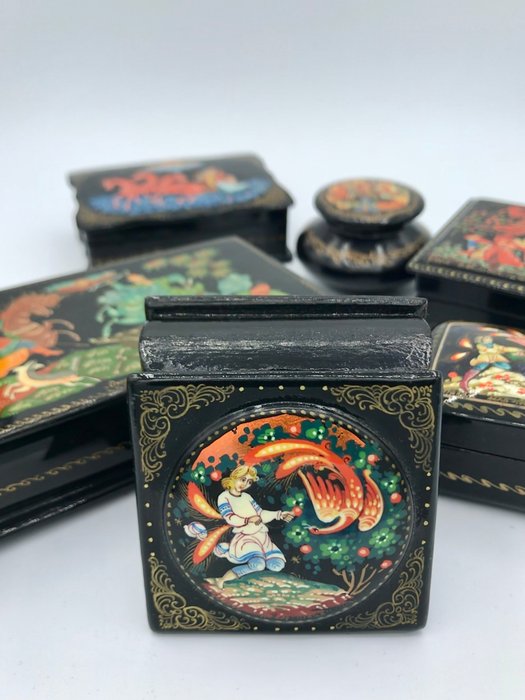Nr 17056127

Six beautiful Russian Palekh Laqcuer boxes, hand painted art, in perfect condition
Nr 17056127

Six beautiful Russian Palekh Laqcuer boxes, hand painted art, in perfect condition
Six very beautiful Russian Palekh lacquer boxes, all in perfect condition. The cases have various measurements Signed and numbered.
Hand-very fine mythical figures painted. With the typical red inside.
Egg tempera, paper mashe, Gouache, Palekh, Russian hand painted lacquer box, collectible, art Russian troika.
dimensions box: 14 x 7 x 3 cm
dimensions box: 9 x 6 x 3 cm
dimensions box: 7 x 5 x 3.5 cm
dimensions box: 5.5 x 5.5 x 2, 5 cm
dimensions box: 4.5 x 4.5 x 2, 5 cm
Diameter box 6: 6, 5 cm x 3, 5 cm
See the photos for signature.
In excellent condition (see photos).
The lot will be well packed and shipped by insured post.
The painting of Palekh Lacquer Boxes began in 1923 in the village of Palekh, Ivanovo Oblast in the district or. The technology of developing a finished painting or box was taken from the lacquer masters of handicraft of Fedoskino. The Palekh miniatures were reminiscent of characters or real life and works, fairy tales, and songs. Painted with bright colours and underlayment or gold and silver distinguished these artists, representing many of the iconic styles of earlier paintings.
Palekh since the pre-Petrine times was famous for its icon painters. The greatest flourishing of Palekh iconography reached the XVIII - early XIX century. Local style was formed under the influence of Moscow, Novgorod, Stroganov and Yaroslavl schools. In addition to icon painting, the Paleshans were engaged in monumental painting, participating in the painting and restoration of churches and cathedrals, including the Faceted Chamber of the Moscow Kremlin, the temples of the Trinity-Sergius Lavra, the Novodevichy Monastery.
After the revolution of 1917 the Palekh painters were forced to look for new forms of realizing their creative potential. In 1918 the artists created the Artistic Decorative Palekh Artel, which was engaged in painting on wood. The ancestors of the Palekh style are Ivan Golikov and Alexander Glazunov, whose Moscow workshop Ivan Golikov wrote the first work in the so-called Palekh style. The Palesans got acquainted with the new material papier-mache, which for a century was the basis for the lacquer miniature Fedoskina. The masters mastered the new material, transferring to it the traditional for the ancient Russian icon-painting technology and conventional image stylistics. For the first time Palekh miniatures on paper mache made at the request of the Handicraft Museum were presented at the All-Russian Agricultural and Artisanal Exhibition in 1923, where they were awarded diplomas of the 2nd degree.
Ten przedmiot został zaprezentowany w
Jak kupować w serwisie Catawiki
1. Odkryj coś wyjątkowego
2. Złóż najwyższą ofertę
3. Dokonaj bezpiecznej płatności
